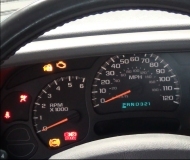That engine uses a camshaft position sensor and a crankshaft position sensor. Signals are needed from both of them for the Engine Computer to turn on the automatic shutdown (ASD) relay. The computer turns that relay on for one second when you turn the ignition switch to "run", then again during engine rotation, (cranking or running). You should hear the fuel pump run for that first one second too.
When the ASD relay turns on, it sends voltage to the coil pack, injectors, oxygen sensor heaters, and alternator field on the dark green / orange wire. It is real common for either sensor to fail intermittently by becoming heat-sensitive. They fail when they get warm, then work again after cooling down. The no-start / stalling is the symptom and is caused by the loss of spark, fuel pressure, and injector pulses. Many people find the missing spark and get stuck in that circuit.
There are a few ways to approach these suspect sensors. First, once the engine stalls and won't restart, use a test light or voltmeter to measure the voltage on that dark green / orange wire in the coil pack connector or at any injector. You will see 12 volts there for one second when you turn on the ignition switch. What is important is it must come back during cranking. If it does, you must determine which is missing, fuel pressure or spark.
More likely the 12 volts won't come back during cranking. If you have access to a scanner that displays live data, it will list the two sensors and "yes" or "present", or "no". If one of the signals is missing, the sensor is the logical suspect but there could be an intermittent or corroded connection in the connector too. Usually a diagnostic fault code will be set in memory in the Engine Computer too that will indicate the circuit with the problem. Chrysler makes retrieving fault codes real easy. Cycle the ignition switch from "off" to "run" three times within five seconds, then leave it in the run position. After a few seconds the Check Engine light will flash out a series of two-digit codes. It will often start with one flash, a short pause, two flashes, then a longer pause before the next code starts. That's code 12 which can be disregarded. The last code will be 55 which just means "end of message". It's the codes in between that are important. Try that procedure and holler back with any codes that you find. When there are intermittent problems that don't act up for a while, any related codes will erase automatically after starting the engine 50 times. Those codes also erase if you disconnect the battery or let it run dead. It's important to not do that or that valuable information will be lost.
Thursday, June 23rd, 2011 AT 5:45 AM





